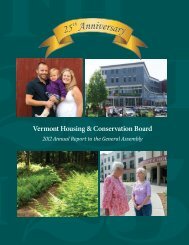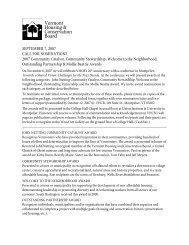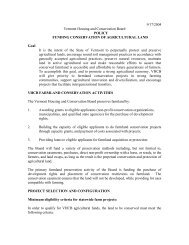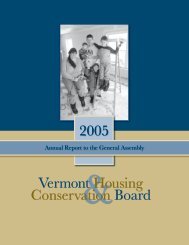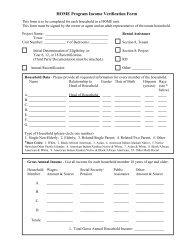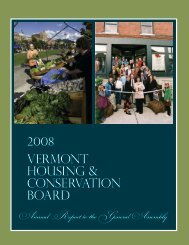policies and priorities - Vermont Housing and Conservation Board
policies and priorities - Vermont Housing and Conservation Board
policies and priorities - Vermont Housing and Conservation Board
You also want an ePaper? Increase the reach of your titles
YUMPU automatically turns print PDFs into web optimized ePapers that Google loves.
<strong>Vermont</strong> <strong>Housing</strong> & <strong>Conservation</strong> <strong>Board</strong><br />
VERMONT LEAD-BASED PAINT HAZARD REDUCTION PROGRAM<br />
POLICIES AND PRIORITIES<br />
The <strong>Vermont</strong> <strong>Housing</strong> <strong>and</strong> <strong>Conservation</strong> <strong>Board</strong> hereby adopts the following <strong>policies</strong> <strong>and</strong><br />
<strong>priorities</strong> for the administration of its Lead-Based Paint Hazard Reduction Program (“Program”),<br />
funded by the U.S. Department of <strong>Housing</strong> <strong>and</strong> Urban Development (“HUD”).<br />
Goals<br />
• To create affordable lead-safe housing in a manner that maximizes the number of young<br />
children protected.<br />
• To collaborate closely with the <strong>Vermont</strong> Department of Health (VDH) to conduct education<br />
<strong>and</strong> training outreach on lead paint safety, State <strong>and</strong> federal lead paint laws, <strong>and</strong> related<br />
topics.<br />
• To work with the Childhood Lead Poisoning Prevention Program (CLPPP) at VDH to<br />
complete lead hazard control work in units where children have been poisoned.<br />
• To create perpetually affordable lead-safe units through collaboration with a network of<br />
nonprofit housing developers.<br />
• To integrate lead hazard reduction into housing rehabilitation programs funded under the<br />
<strong>Vermont</strong> Community Development Block Grant Program <strong>and</strong> other federal funding sources.<br />
• To support proactive l<strong>and</strong>lords, homeowners with young children, <strong>and</strong> in-home child care<br />
providers wishing to make their properties lead-safe.<br />
• To support development of a sustainable infrastructure <strong>and</strong> delivery system for lead<br />
education, testing/inspection, <strong>and</strong> hazard reduction.<br />
• To create training <strong>and</strong> job opportunities for low-income <strong>Vermont</strong>ers.<br />
All program activities will be closely coordinated with the <strong>Vermont</strong> Department of Health (the<br />
designated lead agency for lead hazard issues) <strong>and</strong> implemented in cooperation with all <strong>Vermont</strong><br />
organizations having an interest in lead hazard reduction.<br />
All program activities will be conducted in conformance with the protocols outlined in the HUD<br />
document entitled: Guidelines for the Evaluation <strong>and</strong> Control of Lead-Based Paint Hazards in<br />
<strong>Housing</strong> (June 1995, rev. 1997), <strong>and</strong> as it may be amended or revised in the future; the <strong>Vermont</strong><br />
Regulations for Lead Control, EPA 40 CFR part 745, <strong>and</strong> HUD 24 CFR part 35.<br />
Selection of Units<br />
1. All homes <strong>and</strong> apartments selected for participation in the program will meet the following<br />
eligibility requirements:<br />
(a) Units receiving HUD grant funds for lead paint hazard reduction work will meet the<br />
eligibility requirements established by Title X (The Residential Lead-Based Paint Hazard<br />
Reduction Act of 1992), the HUD Notice of Funding Availability dated April 25, 2003<br />
<strong>and</strong> other Administrative Guidance issued by HUD.<br />
(b) Units receiving Community Development Block Grant Program funds or <strong>Vermont</strong><br />
<strong>Housing</strong> Financing Agency funds for lead paint hazard reduction will meet the eligibility<br />
requirements of the funding organization(s).<br />
VHCB Lead-Based Paint Hazard Reduction Program - Policies & Priorities 09/09/03 Page 1 of 5
2. Selection of eligible units for assistance will be based on the following descending order of<br />
<strong>priorities</strong>:<br />
(a) Units with lead paint hazards occupied by severely lead poisoned children as<br />
identified by the <strong>Vermont</strong> Department of Health (BLL 20+ ug/dl)<br />
(b) Units with lead paint hazards occupied by moderately lead poisoned children as<br />
identified by the <strong>Vermont</strong> Department of Health (BLL 10-19 ug/dl)<br />
(c) Units with lead paint hazards occupied by households with a child age 6 or under or<br />
units where in-home day care centers provide services to children age six or under.<br />
(d) Units with lead paint hazards <strong>and</strong> two or more bedrooms.<br />
(e) Units with lead paint hazards <strong>and</strong> one bedroom.<br />
(f) All other target units.<br />
3. Program staff will be responsible for the determination of eligibility <strong>and</strong> selection of units.<br />
Beyond the <strong>priorities</strong> listed above, other factors may affect whether or not a particular project<br />
will be funded, including but not limited to: number of children protected, structural<br />
condition of property, level of intervention required, cost, time on waiting list, property<br />
owner contribution, <strong>and</strong> likelihood of occupancy by families with young children.<br />
Applicants who are dissatisfied with eligibility determinations, priority selection or other<br />
decisions made by Program staff may have the determination or decision reviewed by the<br />
Executive Director.<br />
Assistance Provided<br />
1. The owners of all eligible units selected for participation in the program will receive the<br />
following services at no cost to the property owner:<br />
• XRF inspection, dust wipe <strong>and</strong> soil sampling, <strong>and</strong> laboratory analysis to determine the<br />
presence of lead-based paint <strong>and</strong> evaluate the potential lead hazards.<br />
• Technical assistance from Program staff with hazard assessment, intervention strategies,<br />
specification development, bidding <strong>and</strong> contractor selection, <strong>and</strong> construction<br />
management.<br />
• Resident education <strong>and</strong> relocation assistance for tenants<br />
• Clearance testing at the completion of lead hazard control activities to insure units can be<br />
safely re-occupied.<br />
• Air duct cleaning (if applicable)<br />
2. Funding in support of lead hazard reduction activities will be made available as follows:<br />
Non-Profit Owned Rental Property undergoing Moderate or Substantial Rehabilitation<br />
Where lead hazard control activities will be completed as part of moderate or substantial<br />
rehabilitation of a property, non-profit owners can receive grants, on average, of $3500<br />
per eligible housing unit. Actual amounts awarded will be determined on a project-byproject<br />
basis, taking into account the total cost for appropriate hazard reduction activities,<br />
the availability of other funding resources <strong>and</strong> the Program’s matching commitment<br />
obligations. Non-profit owners must assure long-term affordability of the housing units<br />
receiving assistance.<br />
Non-Profit Owned Rental Property Undergoing Lead Hazard Control Only<br />
Non-profit owners of eligible rental properties who assure long-term affordability of the<br />
units may receive lead program funding in the form of grants as follows:<br />
VHCB Lead-Based Paint Hazard Reduction Program - Policies & Priorities 09/09/03 Page 2 of 5
(a) up to $10,000 per unit in multi-family housing (units having one or more<br />
bedrooms);<br />
(b) up to $15,000 per single family rental.<br />
Investor Owned Rental Properties<br />
Owners of eligible rental properties may receive lead program funding per eligible unit as<br />
follows:<br />
• grant of up to $3,000; <strong>and</strong><br />
• deferred loan (interest free <strong>and</strong> payable when unit is sold) of up to $7,000.<br />
• Forgiveness of 5% of deferred loan amount for each year that owner completes<br />
essential maintenance practices (EMPs) according to <strong>Vermont</strong> law. Affidavits of<br />
Performance of EMPs must be appropriately filed with the <strong>Vermont</strong> Department of<br />
Health each year. Up to 25% of loan can be forgiven in this manner.<br />
• Forgiveness of 5% of deferred loan amount for each year that owner continues to rent<br />
the unit to the initially eligible household, or if the household vacates the unit, to<br />
another family with a child age 6 or under at the time of initial lease-up. The owner<br />
will be required to provide documentation of occupancy to VHCB staff. Up to 25% of<br />
loan can be forgiven in this manner.<br />
Homeowners<br />
Eligible homeowners with children age 6 or under may receive lead program funding as<br />
follows:<br />
• grant of up to $6,000; <strong>and</strong><br />
• deferred loan (interest free <strong>and</strong> payable when home is sold) of up to $14,000.<br />
• Forgiveness of 5% of deferred loan amount for each year that owner continues to own<br />
<strong>and</strong> occupy the property <strong>and</strong> maintain it in good condition. Up to 50% of loan can be<br />
forgiven in this manner.<br />
Other eligible homeowners may receive lead program funding as follows:<br />
• grant of up to $3,000; <strong>and</strong><br />
• deferred loan (interest free <strong>and</strong> payable when home is sold) of up to $7,000.<br />
• Forgiveness of 5% of deferred loan amount for each year that owner continues to own<br />
<strong>and</strong> occupy the property <strong>and</strong> maintain it in good condition. Up to 50% of loan can be<br />
forgiven in this manner.<br />
Emergency Situations<br />
In situations involving a unit occupied by a child with a confirmed blood lead level in<br />
excess of 20 micrograms/deciliter where the <strong>Vermont</strong> Department of Health has<br />
determined that the poisoning is a result of lead-based paint hazards, additional funds<br />
may be granted in order to undertake abatement or hazard reduction activities. Such<br />
awards must be approved, on a case by case basis, by the Executive Director, <strong>and</strong> will be<br />
subject to the availability of funds.<br />
Funding commitments for grants <strong>and</strong> loans for hazard reduction activities will, as a general<br />
rule, be made by the Executive Director or designee. Award decisions on units in which the<br />
hazard reduction activities are part of a moderate or substantial rehabilitation effort involving<br />
other VHCB funding resources will be made in conjunction with <strong>Board</strong> review of the project.<br />
The Executive Director will consult with the <strong>Board</strong> Chair or designee regarding grant awards<br />
in excess of $150,000 per project. Staff shall provide a program status report to the <strong>Board</strong> at<br />
its regular meetings which shall include a listing of grants awarded.<br />
3. Recognizing that the financial assistance available with HUD funds is often not sufficient to<br />
VHCB Lead-Based Paint Hazard Reduction Program - Policies & Priorities 09/09/03 Page 3 of 5
fully cover the cost of appropriate lead hazard reduction activities, Program staff will work<br />
actively to facilitate the availability <strong>and</strong> accessibility of other resources, including, but not<br />
limited to: owner financing <strong>and</strong> sweat equity, revolving loan funds, private financing, <strong>and</strong><br />
other available housing assistance.<br />
Intervention Strategies<br />
Evaluation <strong>and</strong> intervention strategies, techniques <strong>and</strong> treatments for individual units will be<br />
consistent with the guidance provided in the HUD Guidelines for the Evaluation <strong>and</strong> Control of<br />
Lead-Based Paint Hazards in <strong>Housing</strong> (1995, rev. 1997), as it may be amended or revised in the<br />
future. HUD requires that the Program address all identified lead paint hazards in properties<br />
receiving assistance. This is achieved through a combination of interim controls <strong>and</strong> abatement<br />
of lead hazards that typically includes window replacement, stabilization of deteriorated<br />
surfaces, covering lead painted floors, <strong>and</strong> addressing other friction areas like doors <strong>and</strong> door<br />
jambs. A specialized cleaning <strong>and</strong> clearance testing are conducted before residents are allowed<br />
to re-occupy the residence.<br />
Vacant housing being rehabilitated by nonprofit organizations typically receives the most<br />
comprehensive treatment because renovations are substantial <strong>and</strong> more lead-painted components<br />
are removed or covered. These units will remain perpetually affordable to low <strong>and</strong> moderate<br />
income households <strong>and</strong> are likely to serve families with young children. Although treatments are<br />
substantial, lead costs are lower because of overlap with rehab activities. Occasionally this<br />
strategy is also used with investor-owners doing substantial remodeling or renovations.<br />
Where only lead hazard control work will be undertaken the intervention strategy typically<br />
includes more ‘in-place management’ of lead hazards. Certain components, like windows, are<br />
almost always replaced because they pose the greatest hazard. But other components <strong>and</strong><br />
surfaces are stabilized <strong>and</strong> repainted to eliminate the hazardous conditions. St<strong>and</strong> alone lead<br />
hazard control work requires substantially more Program resources for coordination, project<br />
design, construction oversight, <strong>and</strong> all of the work. Properties where a young child has been<br />
seriously lead poisoned may receive a higher level of intervention to prevent a reoccurrence.<br />
When designing lead hazard control projects, Program staff first address lead paint hazards on<br />
the interior of the property. Interiors are where young children are most at risk of ingesting lead.<br />
Exterior hazards (typically deteriorated paint on clapboards/trim) are then addressed with<br />
remaining Program <strong>and</strong> property owner resources. Exterior paint stabilization work can be<br />
completed by workers or property owners who have completed a lead safe work practices<br />
training (i.e. <strong>Vermont</strong>’s Essential Maintenance Practices class). A majority of owners perform<br />
some sweat equity work for their projects, most commonly repainting of treated surfaces.<br />
To the extent possible, Program staff provide technical assistance <strong>and</strong> advice to the general<br />
public as requested, including limited visual assessments, sampling, <strong>and</strong> laboratory analysis. The<br />
Program works closely with all federally funded housing assistance programs in the State to<br />
insure compliance with the federal Lead Safe <strong>Housing</strong> Regulation, including the provision of<br />
free clearance examinations. Funding for these services comes from the repayment of loans<br />
awarded under previous grants.<br />
All projects funded by this Program are subject to review under Section 106 of the National<br />
Historic Preservation Act. The proposed lead safety treatment for each property receiving<br />
assistance is reviewed for appropriateness by an historic preservation consultant under a<br />
Programmatic Agreement between VHCB, the <strong>Vermont</strong> Division of Historic Preservation, HUD,<br />
VHCB Lead-Based Paint Hazard Reduction Program - Policies & Priorities 09/09/03 Page 4 of 5
<strong>and</strong> the Advisory Council. While recognizing the importance of preserving the historic character<br />
of older structures, this Program gives priority to insuring lead safety for resident children.<br />
Public Education / Outreach<br />
The VHCB Lead Paint Program will work closely with the Childhood Lead Poisoning<br />
Prevention Program (CLPPP) at the <strong>Vermont</strong> Department of Health <strong>and</strong> the <strong>Vermont</strong> Lead<br />
Safety Project to increase awareness about lead poisoning <strong>and</strong> promote compliance with the<br />
State’s lead paint laws for rental housing <strong>and</strong> child care facilities. These efforts will include the<br />
provision of free lead safety/essential maintenance practices training sessions throughout the<br />
State for property owners, child care providers maintenance personnel, contractors, painters, <strong>and</strong><br />
others working in older residential properties.<br />
VHCB Lead-Based Paint Hazard Reduction Program - Policies & Priorities 09/09/03 Page 5 of 5



